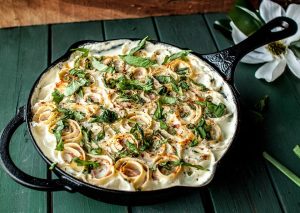
Italian cuisine is renowned worldwide for its rich flavors, unique ingredients, and traditional recipes. Among the many regional specialties, Rosette stands out as a classic Italian dish with a long history and a loyal following. In this article, we’ll explore the origins, ingredients, and preparation of Rosette Italian food, as well as its variations and cultural significance.
What is Rosette?
Rosette is a type of Italian pasta that resembles a small rosette or rose. It’s also known as Fiorelli or Fiori di Siena, which means “flowers of Siena,” a reference to the city in Tuscany where it’s said to have originated. Rosette pasta is made from a simple dough of flour and water, sometimes with eggs or semolina added for a richer texture. The dough is rolled out thinly and cut into small circles, which are then twisted and folded to form the characteristic shape of a rosette.
Ingredients and Preparation
The beauty of Rosette pasta is that it can be paired with a wide variety of sauces and ingredients, depending on the season, the region, or the personal taste. In general, Rosette dishes tend to be light and fresh, with a delicate balance of flavors and textures. Some common ingredients used in Rosette pasta recipes include:
- Tomatoes: Fresh or canned, tomatoes are a staple in Italian cooking and add a sweet, tangy flavor to Rosette dishes. They can be used in a simple tomato sauce or combined with other vegetables and herbs.
- Cheese: Parmesan, Pecorino Romano, and other hard cheeses are often grated over Rosette pasta for a salty, nutty taste. Soft cheeses like ricotta or goat cheese can also be used as a filling for the rosettes.
- Vegetables: Asparagus, zucchini, peas, and spinach are popular choices for Rosette pasta recipes, either as a sauce or a filling. They add color, texture, and nutrients to the dish.
- Meat: While Rosette pasta can be a vegetarian dish, it also pairs well with chicken, pork, or seafood. Grilled or sautéed meats can be served alongside the pasta or mixed into the sauce.
To prepare Rosette pasta, you’ll need to boil it in a pot of salted water for a few minutes, until it’s al dente or tender but still firm. Then, you can toss it with your preferred sauce or arrange it in a baking dish with layers of cheese and vegetables. Some Rosette dishes are baked in the oven until the cheese is melted and bubbly, creating a delicious crust on top.
Regional Variations
As with many Italian dishes, Rosette pasta has different variations and names depending on the region or the town. Here are some examples:
- Rosette alla Sienese: The classic Rosette pasta recipe from Siena, which includes a sauce made with tomato puree, garlic, basil, and pecorino cheese.
- Rosette alla Romana: A Roman version of Rosette pasta, which features a sauce made with pancetta (cured pork belly), onions, white wine, and tomato paste.
- Rosette alla Genovese: A Ligurian variation of Rosette pasta, which combines a sauce made with caramelized onions, beef broth, and white wine with grated Parmesan cheese.
Cultural Significance
Rosette Italian food is not only a delicious meal but also a symbol of Italian culture and heritage. The intricate shape of the rosettes reflects the Italian passion for aesthetics and beauty, while the simple ingredients and preparation represent the country’s emphasis on freshness and quality. In many Italian households, Rosette pasta is a traditional dish served on special occasions, such as holidays or family gatherings, as a way to honor the culinary traditions and bond over food.
Moreover, Rosette pasta has also become a popular dish in Italian restaurants and beyond, as a symbol of Italian cuisine and a delicacy for food enthusiasts. Many chefs and cooks have put their own spin on Rosette pasta, experimenting with different sauces, fillings, and presentation styles to create unique and innovative dishes.
Overall, Rosette Italian food is a delightful culinary experience that captures the essence of Italian cuisine: simple yet elegant, flavorful yet balanced, and rooted in tradition yet open to interpretation. Whether you’re a fan of classic recipes or creative twists, Rosette pasta is a must-try dish that will take your taste buds on a journey to Italy and beyond.
Conclusion
Rosette Italian food is a beloved dish that combines simplicity, elegance, and flavor in a unique way. Whether you’re a fan of tomato sauce or cheesy fillings, Rosette pasta offers endless possibilities for customization and creativity. By exploring the origins, ingredients, variations, and cultural significance of Rosette pasta, we hope to have inspired you to try this classic Italian dish and discover the magic of Italian cuisine.
FAQs
- Is Rosette pasta the same as fusilli? No, Rosette pasta has a different shape and texture than fusilli. While fusilli is spiral-shaped and twisted, Rosette pasta resembles a small rose or flower.
- Can Rosette pasta be made from scratch? Yes, Rosette pasta can be made from scratch using a simple dough of flour and water. You can also add eggs or semolina for a richer texture.
- What’s the best sauce for Rosette pasta? It depends on your taste preferences and the ingredients you have on hand. Some popular sauces for Rosette pasta include tomato sauce, pesto, cream sauce, and meat sauce.
- Is Rosette pasta a traditional Italian dish? Yes, Rosette pasta has a long history in Italian cuisine, particularly in Tuscany, where it’s said to have originated. However, it also has variations and adaptations in other regions of Italy.
- Can Rosette pasta be served cold? Yes, Rosette pasta can be served cold in salads or cold pasta dishes, along with fresh vegetables, cheese, and dressing.
